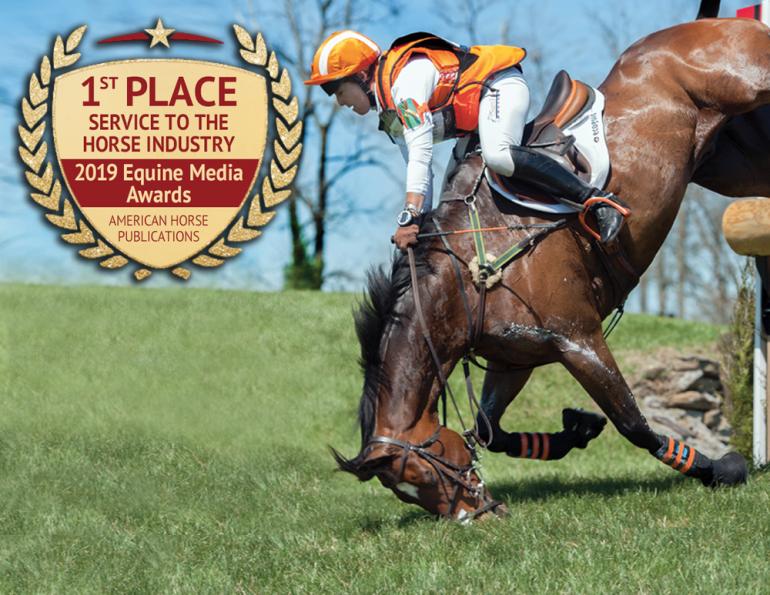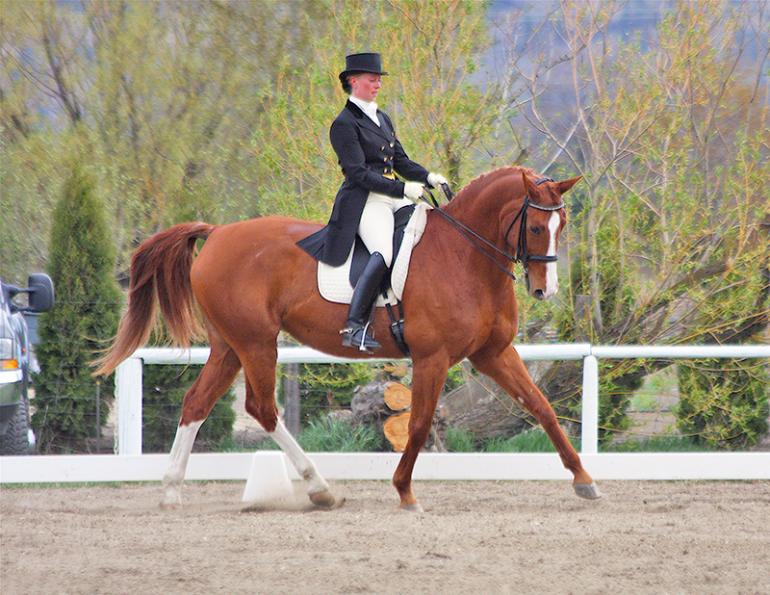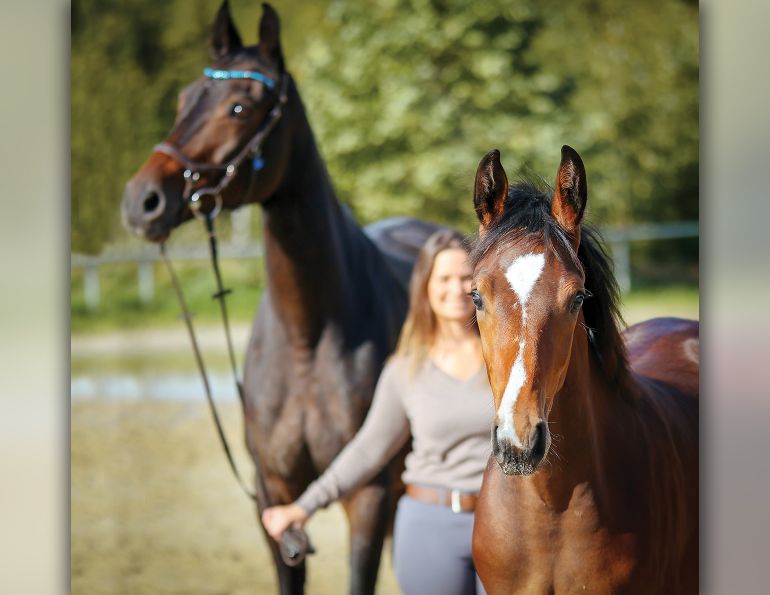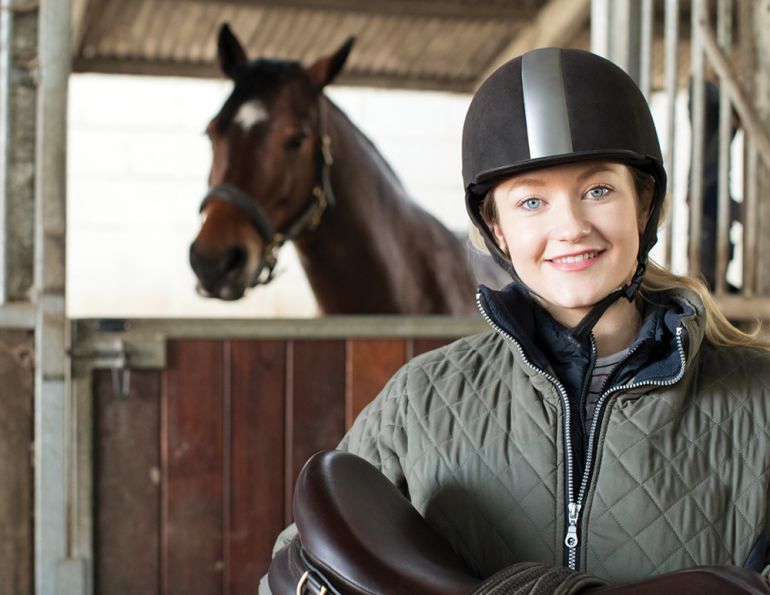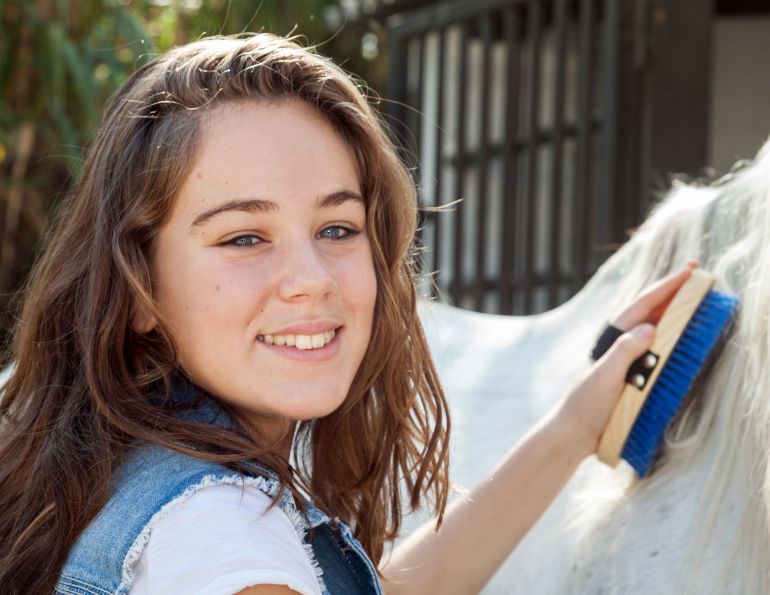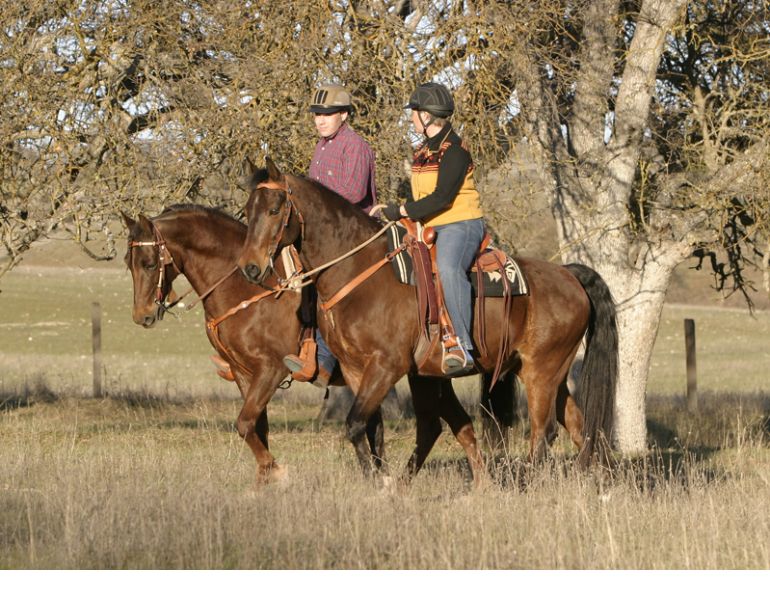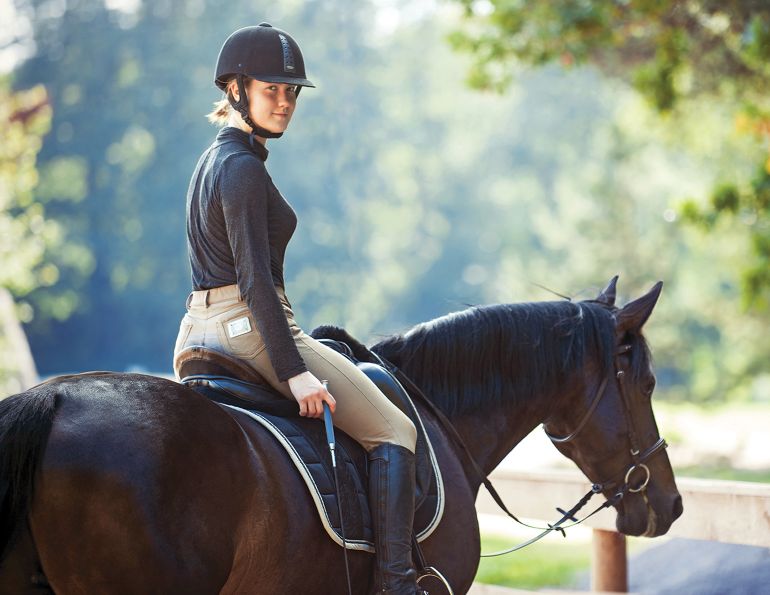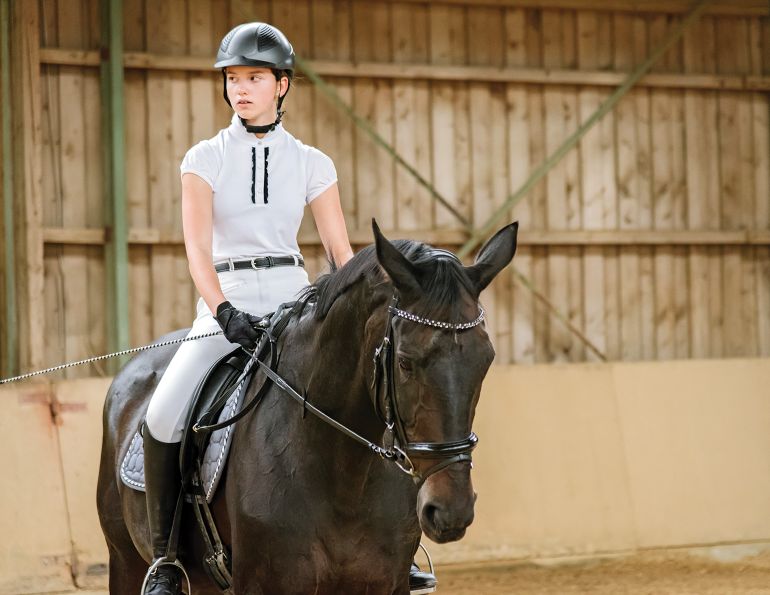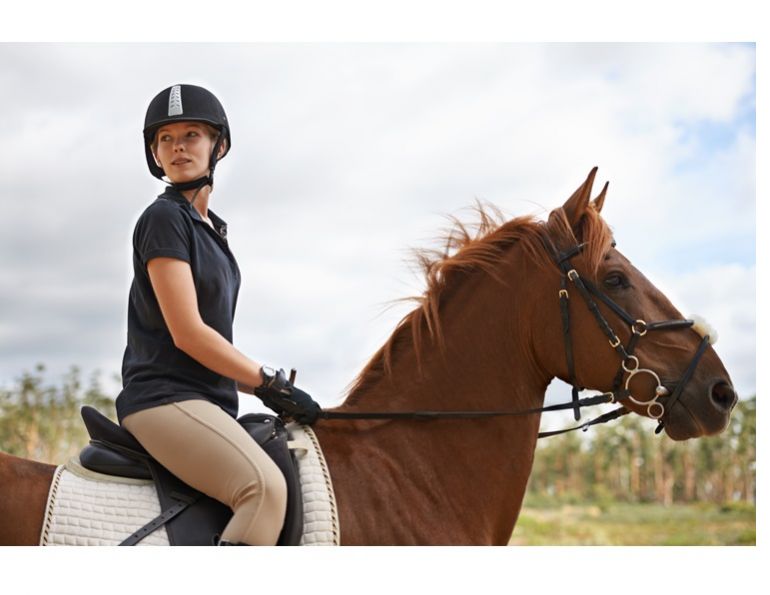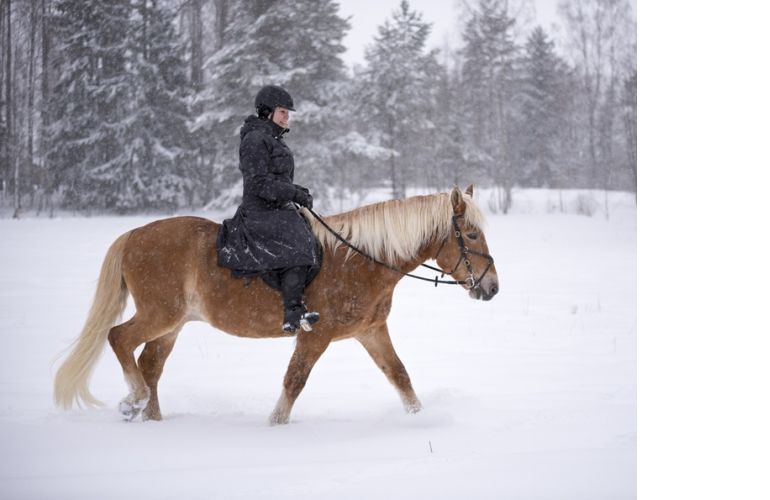Safer Landings
“There never was a horse that couldn’t be rode; there never was a rider that couldn’t be throwed.” – Will James, cowboy
By Margaret Evans
In January 2003, Penny Woodworth, who lives on Vancouver Island, BC, was taking a jumping lesson. “Smallish jumps, nothing exciting. My long-time error is looking down, which I did that day. My horse stopped, and I tumbled off. Not a bad fall at all, except that I landed with one butt-cheek on the ground pole. I got up and carried on, but I was crooked and stayed that way. After a week or so, still riding crooked and feeling shooting pains down my right leg, I went for physiotherapy. I had dislocated my sacroiliac (SI) joint. Regular physio treatments and exercises finally got it to stay in place and I continued riding.
“Later that summer, I attended a horse show where my horse had had some bad experiences and he was freaked out. In retrospect we should have taken him home, but we thought he would settle. He didn’t. In my first class he bolted, and we crashed into a fence. I got back on and rode him for a while in the warm-up ring, but we gave up on the show. A couple of days later, in a lesson, he did a sudden violent sideways spook that dumped me once more, but I mounted up and finished the lesson.

Photo: Shutterstock/Mana Photo
“Forty-eight hours later, I tried to put my boots on and could not bend down. I could not sit. Back to my physiotherapist who took one look at me and said, ‘You’ve blown a disc. Who’s your doctor?’ I went on rest and pain management for three months. At the end of that time it wasn’t better. It was far worse. I couldn’t work. I was in agony, popping 50mg of morphine a day, and could not sit or stand for more than about five minutes. A CT scan did indeed show that my L4-L5 disc was ruptured, but my symptoms (muscle atrophy and pain radiating down my leg) indicated L5-S1. A visit to the neurosurgeon brought the diagnosis that I had a sequestered disc. A piece had broken off, travelled down the spinal canal and was lodged against my sciatic nerve. It’s one of the few cases where surgery helps, and it did for me.”
The experience left Woodworth with zero core strength and shattered confidence.
She tried to get back into jumping and worked with a sports psychologist, but occasional white-out panic would plague her even in the middle of a tiny course. While she did recover her nerve to ride and even to show, jumping was confined to carefully controlled lessons.
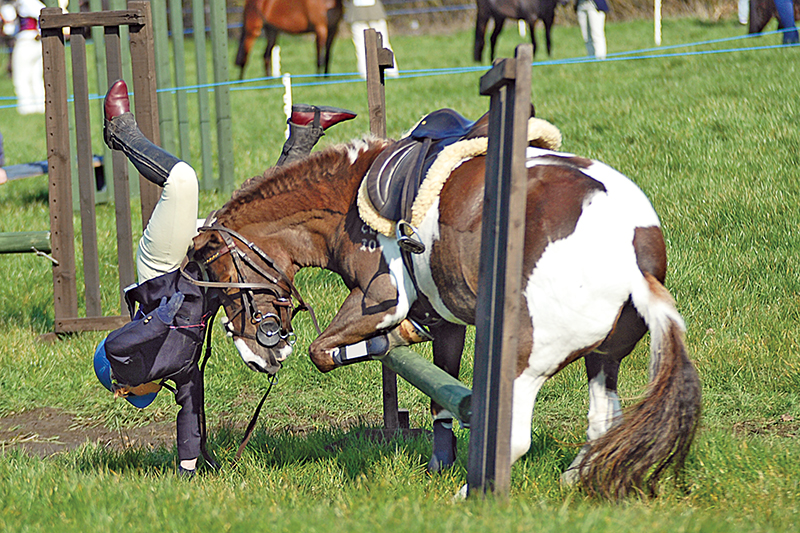
When children take riding lessons, they are taught to stay on the horse, but seldom do they learn techniques to protect from injury during a fall. Photo: iStock/Inshot
“None of these falls was spectacular but there was likely a connection to the severity of my injury. The damage done in the first one weakened my core strength enough that I fell more easily and allowed greater damage to be done, probably because the falls were close together.”
At some point, we’ve all been there. A fall during a simple ride hacking along a trail, working out in the arena, schooling over jumps, or on an eventing cross-country course, can turn an ordinary day into a traumatic event.
Falling off a horse isn’t something we plan on, but it is an eventuality we need to plan for. The vast majority of falls are straightforward, and the rider can get up unhurt, ready to remount and continue the ride with little more than an annoying bruise. But in a nanosecond a fall can go sideways and result in serious or catastrophic injury, or it can be fatal.
Unfortunately, fall safety techniques or how to protect oneself from injury during a fall are seldom taught and even less understood. Riding is widely recognized as a risk sport. A rider is sitting atop a 1,100-pound animal with many moving parts and a mind of its own. As prey animals, horses use flight as their primary defense mechanism, so when they perceive danger, their instinct is to shy and jump away, or to flee and bolt. An unruly horse that unseats its rider, a misstep on uneven ground, a jump refusal or stumbling on landing can also result in a fall, and if the horse hits a solid fence it can cause a rotational fall.
When children take swimming lessons, they are taught essential water safety skills to help protect them from drowning. When learning gymnastics, they are taught proper body and landing positions, and how to roll out of a dismount. Riders are taught to stay on the horse, and although falling is an inevitable part of riding, most riders are woefully unprepared when it happens.
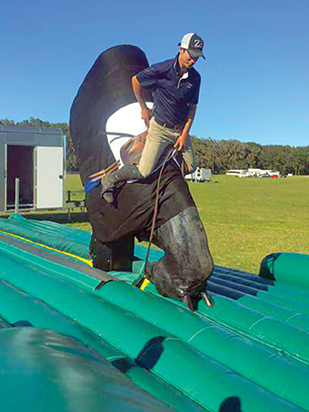
Landsafe Equestrian teaches riders how to fall using a mechanical horse that stops and tosses the rider onto an air-padded mattress.
Many riders and coaches spend the majority of their time and energy on improving their horses’ movement and overall carriage, but much of the harmony and unity they are striving for can be improved by the rider focusing on improving their own balance, flexibility, and strength. And not only should riders be fit to ride, they should ride defensively and have some basic skills in play when danger looms. Fitness is one of the strongest defenses against injury, as it will speed reaction time, improve balance, and increase agility.
Learning to Fall
It’s not a question of whether you are going to fall or need to bail off your horse, it’s a question of when. Be prepared with some proactive strategies. Start with understanding how to fall and roll away, then practice on soft ground such as a sandy arena, wearing regular riding clothes and helmet. Have someone with you to watch the exercise and video it so that you can review your actions.
Kneel on one knee and, as you do, turn your head and shoulders away from the direction of your intended fall, then drop to the ground, landing on the blade of your shoulder. Draw your knees up, bring up your arms to protect your head in a curl with your chin tucked toward your chest, continue the rotation onto your back, and roll over onto your knees. Once on your knees, immediately get to your feet. Do this exercise many times and in both directions, dropping onto alternate knees to roll. When you are really comfortable with it, you can increase the height a little by standing on a mounting block or low stool. Not every fall from a horse is going to be like this, but it’s a starting place to allow you to experience the mechanics of a fall.
“Some riders have a natural ability to respond better in a fall than others,” says Lindsay Nylund, owner of Horse Rider Fall Safety Training in New South Wales, Australia. “However, everyone can improve their skills. While there will be factors other than rider fall skills that may affect injury outcome, such as rider fitness level and the nature of the fall, being trained in how to respond will not make things worse in a fall. Once a fall is inevitable with no prospect of recovery, let go of the reins, get the arms into a brace position, land and tuck-and-roll maintaining muscle tension.”
Related: Head First Horse Riding Accidents and Concussions
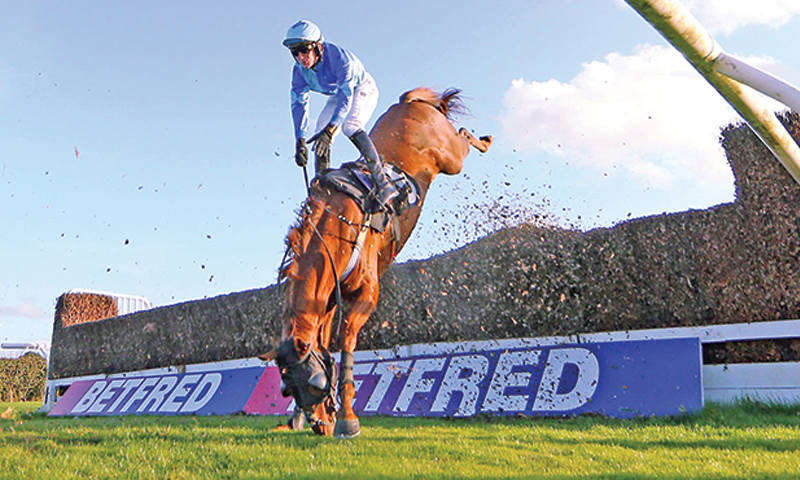
“The risk of having a serious injury is once every 55 falls. A rotational fall, however, increases the risk to once every five falls.” – LandsafeEquestrian.com. Photo: Alamy-Telephoto Images
Horse Rider Fall Safety Training features gymnastic equipment including landing mats and crashmats, mini-trampoline, foam shapes to teach landing from height and at speed, and a replica and mechanical horse.
“It is true that some riders have a natural ability to respond better in a fall than others,” he says. “It’s simple but requires some practice to apply in an emergency. The hands need to be turned in to reduce risk of elbow/wrist injury. With some practice the correct arm position can be done without much conscious thought.”
Nylund says that the tuck-and-roll fall safety techniques taught are slightly differently from those taught in standard gymnastics or martial arts techniques.
“Tuck-and-roll for rider fall safety is essentially taught as a body shape irrespective of fall direction so riders do not have to deliberate on fall direction or carry out too much conscious thought in different fall scenarios. Once a rider is rolling, they just need to hang on to their tuck position until they completely stop.”
Vaulting is a unique discipline of riding that combines acrobatic and gymnastic skills and, contrary to many other disciplines, vaulters do not wear helmets when performing.
“Vaulters are taught from the beginning how to roll and keep their heads off the ground,” says Colin Schmidt, former vaulter, coach, and judge based in Chilliwack, BC. “For younger vaulters, this can be as simple as a sideways roll with their arms and legs tucked in. As vaulters progress, they are taught to roll from one shoulder to the opposite hip with the head tucked to one side. It is critical that after the roll the vaulter always finishes back up on their feet so they can be mobile and move away from any lingering danger.”
Schmidt says it is important that the roll technique and the ability to roll out of a fall be taught and practiced incrementally over time as the vaulters’ skills develop, starting with just the simple sideways roll with the emphasis of finishing back up on their feet. From there they slowly increase the height and the distance each vaulter jumps from/to, only progressing to the next level when the rolls are clean, the head stays off the ground, and they finish on their feet consistently.

Horse Rider Fall Safety Training teaches tuck-and-roll fall safety techniques for riders, which are slightly different from those taught in gymnastics or martial arts. Photos courtesy of Horse Rider Fall Safety Training
“It has to be fluid,” says Schmidt. “Don’t stop on a knee. It is better to crouch and stay on the feet. Everything has to be fluid even from the start, because it is the fluidity that disperses the impact of the fall. Always start with gym mats and, after that, soft fluffy sand. Never practice on hard surfaces.”
Danny and Keli Warrington run Landsafe Equestrian in Maryland, US. They offer clinics across the country on how to fall using a custom-designed mechanical horse on a track. At various speeds, the mechanical horse will stop and toss the rider onto an air-padded mattress. Each rider is coached before the exercise, then the fall is analyzed. Danny, a former steeplechase jockey who went on to three-star eventing, and Keli, a former high-level gymnast and a gym coach, both know from experience just how important learning to fall is for riders.
“Two common mistakes riders make are that they follow the horse’s ears with their eyes into the ground and they hang on to the reins for too long, which stops them from putting their arms out to defend themselves,” says Danny Warrington. “Then there is the lack of tucking the chin into the chest and rounding the back.”
Nylund adds that riders who have not been trained come with the view that they should relax into a fall as much as possible.
“To execute good tuck-and-roll skills you need to maintain muscle tension,” says Nylund. “Riders should not fall like a ‘raw egg’ but need to be a ‘hardboiled egg.’ For some riders this is counter-intuitive and hence it needs to be trained. Another common misconception is ‘don’t put your arms out because you might break them.’ In some of the worst fall scenarios (such as head-first fall direction) riders may be of the view that they can alter their fall trajectory in midair to avoid direct head impact. From basic laws of physics, we know that it is not possible to alter fall trajectory once airborne. You can only alter your body shape. Riders need to be trained to use their arms to reduce impact forces on their head and neck.”
That moment when the fall is coming is when you need to give yourself permission to fall. In that second, your focus needs to be on clearing yourself away from your horse by kicking off the stirrups and letting go of the reins. Hanging on can lead to entanglement, getting dragged at speed, getting kicked or trampled, and breaking bones. Let your horse run free; you can retrieve him later. Once you are falling, try to draw yourself into a ball, press your chin to your chest, bring your arms up in a brace position with the elbows slightly bent to protect your head and neck, and bring your knees up. On impact, roll away.
Maybe part of our lack of training is our cultural approach. In times past, if we fell, we were always expected to remount and carry on riding. But whether we were physically ready for the fall was never part of the equation.
“Riders are not doing athletics because they are riders,” says Warrington. “They are not doing a gym program or workout routines. All they do is ride and all they do is practice perfect. But nothing is perfect. The horse comes to a bad situation that results in a fall. We haven’t practiced that. Then we’re surprised by the outcome. To me, it’s not so much that the sport has changed despite changes in technology, qualifications to get to a level, design of the fences, etc. There are all kinds of things that have improved in the sport. But what has not improved is the defensive education of the rider. Everybody wants to have fun, but no one wants to see the danger side and we’re all upset when the danger side shows its ugly face.”
Warrington says that riders need to cross-train and be properly conditioned to do the job — not only to ride, but to be flexible with sufficient core strength to absorb a fall when it happens. Learning fall safety skills will increase a rider’s flexibility, balance, and muscle conditioning.
“You must not only be strong enough to ride your horse but strong enough to absorb a hit if you fall,” he says. “The average fall time is 750 milliseconds, or 0.75 seconds. Human reaction time is 250 milliseconds (0.25 seconds). A baseball travels from the pitcher to the catcher in 500 milliseconds. Baseball organizations spend millions of dollars analyzing that 500 milliseconds and we spend nothing on that 750 milliseconds to analyze a fall.”
Nylund agrees wholeheartedly with rider fitness.
“Rider fitness is a factor that is associated with reduced injury outcomes,” he says. “Arm strength will improve protection to the head/neck. Core (middle body) strength will improve tuck-and-roll skills and protect the rider’s spine in a fall, providing they have been trained in how to tuck-and-roll. Flexibility will improve balance and reduce the risk of falling. Every sport generally includes repetitive activities which can create muscle imbalances. Cross-training is a good method of ‘ironing out’ these imbalances and will not only reduce injury risk but improve overall athletic performance.”
Related: Keeping Children Safe While Handling Horses
Rebuilding Confidence
A bad fall can destroy a rider’s confidence and set up a cycle of fear and apprehension.
“About eight years ago I was schooling in a lesson with my warmblood, Dexter,” says Emma Laliberte in Victoria, BC. “Dexter was like a puppy dog and I had [owned] him from when he was three to about eight years old. Mid-course, we cantered a small 2’9” jump, but we took off a stride too early, something he commonly did as a young green horse. On the landing side, his left leg buckled, causing him to go down on the left side, while my body went right. The next thing I knew, I was pinned underneath Dexter from my waist down. I could feel my spurs stabbing into my other leg.
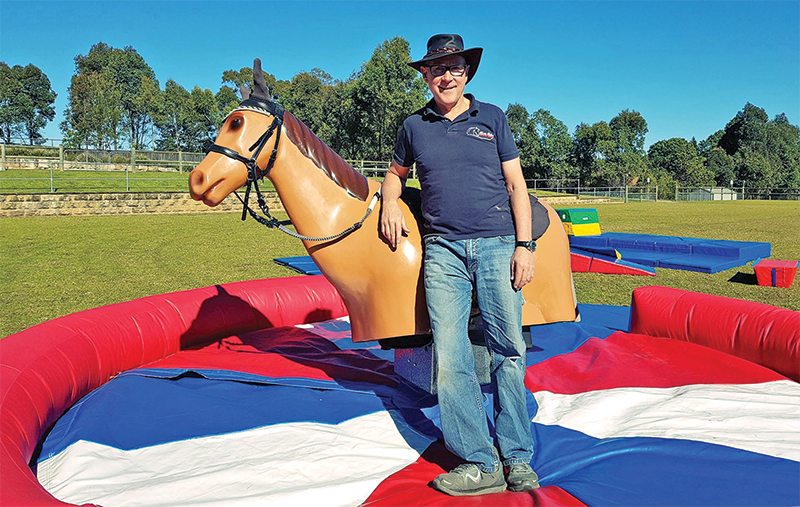
Lindsay Nylund of Horse Rider Fall Safety Training uses gymnastic equipment including mats and a mini-trampoline, as well as a mechanical horse, to teach safe landing from height and at speed. Photo courtesy of Horse Rider Fall Safety Training
“My trainer and another rider’s dad, who was a surgeon, rushed over to figure out how to get him up. I was pinned between his front legs and his back legs, not an ideal situation for a horse to be getting up from. Me and everyone else kept telling Dexter not to move for this reason and, thank God, he didn’t. He just laid there. My trainer sent someone for ropes to try to flip Dexter over [in] the opposite [direction] so that, when he got up, I wouldn’t break my face.
“About five minutes in, Dexter started scrambling and started to get up. I quickly rolled away and escaped a pretty horrifying situation with just a kick or two to the back and head. Somehow both Dexter and I were not seriously injured, but I don’t think either of us were ever the same. It took a very long time to be able to even talk about the incident because so many other things could have gone way worse. I felt so guilty for taking off long to that jump and putting my horse and myself in that situation. Now I know we all make mistakes but nothing worse did happen, and I’m thankful for that. After that I never really aspired to jump big and instead copped out under 3’6” because my mental game has never been the same.”
The mental game of dealing with the experience of a fall can vary from anxiety and lack of confidence to all the crippling effects of post-traumatic stress disorder (PTSD). Pain, trauma, and fear can explode with flashbacks and sleeplessness. Guilt, isolation, unable to talk things through, as well as mood changes play havoc with emotional stability. A network of family and friends as well as an experienced counsellor are essential to helping a rider overcome difficulties.
Our brains are wired to respond instantly to fear, but when people stay on high alert long after the threat has passed, PTSD sets in. A new study from Scripps Research, Florida, suggests it may be possible to disarm traumatic memories and bring about a faster recovery. The research team has identified a key molecule found elevated with the brain’s emotional memory processor, and controlled experiments have suggested that suppressing that molecule may enable a speedier recovery. Much research work is still to be done but results so far look promising.
Mental healing begins with baby steps and there are valuable things people can do to help get their lives back together while they seek professional counselling. Mindfulness-based relaxation, meditation, visualization, positive self-talk, art therapy, pet therapy, and starting a journal can all help to cope with trauma.
When you are ready, physical activity will help rebuild core strength. Walk, jog, hike, join a gym, swim, take up dancing, yoga, or Tai chi. Many focused physical activities are like a moving form of mindfulness and all will build new skills as well as strengths you’ll need when ready to ride again.
Go to the barn. Visit your horse and share a hug. You may not be ready to ride yet, but that sense of connectedness will be important when the time is right. Just experiencing the sights, sounds, and smells of the barn can make you feel at home and on the right path.
The key to rebuilding confidence is to start in a space with clear comfort zones. Before even riding, try working with your horse on the ground grooming, leading, hand grazing, or any controlled activity that is beneficial to your relationship with him. When you are ready to mount, have your trainer or a skilled friend with you and keep things at a walk. You may need to ride a horse other than your own, perhaps an older, quieter mount, to help build your confidence before starting back on your own horse.
Take stock of your riding clothing and equipment. If your helmet took a knock, replace it. If it’s time to upgrade a worn girth or your stirrup leathers, do so. Consider protective equipment like a chest protector. However, it seems the jury is still out on air vests.
“It is not their reliability that’s in question, its whether or not they are effective,” says Warrington. “In my personal experience, they are very effective. But there is more research that needs to be done. My take on air vests is that they don’t prevent you from rolling. If you are going to have a bad fall and you’re going to be in a bad shape when you hit the ground, an air vest is not going to really help you. If you don’t know how to roll across the ground, then an air vest isn’t going to help. Even if you wear an air vest, a body vest, and a helmet, they aren’t going to guarantee that you are safe from injuries.”
Falling is Part of Riding
Learning to fall starts with accepting that a fall can happen. To make falling a more natural part of riding, the vaulting community has turned it into a game.
“When falling is part of the training from the beginning and it is done incrementally without ever pushing the limits, the vaulter should always have complete confidence in their ability to fall from the height and speed they have been trained for so far,” says Schmidt. “We play games, such as Escape Tag, to help pull all the skills together and help ensure they can fall and roll with some speed and without over-thinking it. In Escape Tag, the person being chased can ‘escape’ by rolling and, if they roll, the chaser has to chase someone else; if the escape roll doesn’t complete properly with the one pursued on their feet, they are then stuck on the ground and someone else has to help them up.”

The fun of the game is building speed and a flexible ability to quickly roll out of the reach of the pursuer. The purpose is to encourage young riders not to over-think but to drop and roll instinctively so that it becomes second nature.
In Maryland, Landsafe Equestrian offers three programs — an introduction, a training program, and an advanced program, and the purpose of every level is to teach people how to defend themselves when a fall happens. Courses are offered across the country and very recently they gave their first course in Canada in New Brunswick.
“In Australia, there is growing interest in fall safety training, particularly with Pony Club and adult riders,” says Nylund. “However, there are still a lot of divergent views on the subject matter, for example, some people saying there is no time to respond in a fall. If there is no time to respond in three-quarters of a second (the average fall time in most rider falls), then sports such as gymnastics and baseball would not exist. If fall safety training saves just a small number of riders from catastrophic injury outcomes, it’s worth training every rider on the planet.
“The Australian Parachute Federation, in their training operations manual, has a mandatory requirement that students must be taught a parachute landing roll before they make their first decent. Gymnastic coaches have a mantra, ‘Before you take them up, teach them how to come down.’ One of my favourite quotes is the Mexican proverb, ‘It’s not enough to know how to ride. You must know how to fall.’”
Related: Dangers of Equestrian Activities Studied
Many thanks to our contributors:
Danny and Keli Warrington: LANDSAFE Equestrian
Lindsay Nylund: Horse Rider Fall Safety
Colin Schmidt: Stablebuzz
Main photo: Sharon White and Rafferty’s Rules take a fall at the Rolex Kentucky Three-Day Event. Fortunately, horse and rider were not seriously injured. Photo: Clix Photography



